As the cost of energy escalates, an important issue for many businesses is how to monitor power consumption – for a device, a process, a department or an entire facility. This is typically done with a power meter or energy meter. Before we explore various instruments available for this, a quick review of basic power system parameters is warranted.
The terms power and energy are often imprecisely used. For example, the product the ‘power’ company (electric utility) supplies is energy. An instrument casually called a power meter will often measure energy. Power is a measure of work. Energy is the ability to do work for a period of time. Stated another way, energy is power multiplied by time.
Types of Power for AC Systems
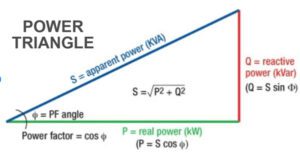
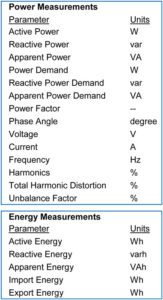 For AC systems, there are three types of power – active (real), reactive, and apparent. The power triangle shows the relationship between these parameters. Active (real) power is the power consumed by the resistive load, typically measured in watts or kilowatts. Active power does work, so it is on the real axis of the triangle. Reactive power is the power temporarily supplied to inductive or capacitive load elements. Reactive power is represented on the imaginary axis of the vector diagram and is measured in vars. For two quarters of each cycle, the product of voltage and current is positive, but for the other two quarters, the product is negative. Although the current associated with reactive power does no work at the load, it still must be supplied by the power source. Practical loads have resistance as well as inductance or capacitance, so both active and reactive currents will flow to these loads. Apparent power is the product of the rms values of voltage and current, or the vector product of real and reactive power. P, Q and S are the SI symbols for these parameters.
For AC systems, there are three types of power – active (real), reactive, and apparent. The power triangle shows the relationship between these parameters. Active (real) power is the power consumed by the resistive load, typically measured in watts or kilowatts. Active power does work, so it is on the real axis of the triangle. Reactive power is the power temporarily supplied to inductive or capacitive load elements. Reactive power is represented on the imaginary axis of the vector diagram and is measured in vars. For two quarters of each cycle, the product of voltage and current is positive, but for the other two quarters, the product is negative. Although the current associated with reactive power does no work at the load, it still must be supplied by the power source. Practical loads have resistance as well as inductance or capacitance, so both active and reactive currents will flow to these loads. Apparent power is the product of the rms values of voltage and current, or the vector product of real and reactive power. P, Q and S are the SI symbols for these parameters.
Demand is the average power level over a period of time, usually 15, 30 or 60 minutes. The typical AC system will have active, reactive and apparent power demand. Each type carries the same units as the corresponding power parameter (W, var, VA).
Power Factor of An AC System
The power factor of an AC system is defined as the ratio of the real power absorbed by the load to the apparent power flowing in the circuit. It is the ratio of the active power, in watts, to the apparent power, in volt-amps. The power factor is 1.0 when the voltage and current are in phase. It is zero when the current leads or lags the voltage by 90 degrees. When power factor is equal to 0, the energy flow is entirely reactive and stored energy in the load returns to the source on each cycle. When the power factor is 1, referred to as unity power factor, all the energy supplied by the source is consumed by the load. In a 3-phase circuit, current and voltage are not in phase, so the power factor will be between 0 and 1. Power factors are usually stated as “leading” or “lagging” to show the sign of the phase angle of current with respect to voltage. Voltage is designated as the base to which current angle is compared, meaning that current leads with a capacitive load or lags with an inductive load. Where the waveforms are purely sinusoidal, the power factor is the cosine of the phase angle between the current and voltage sinusoidal waveforms. Equipment data sheets and nameplates often show power factor as cos φ.
The fundamental frequency is the primary system operating frequency, usually 50 or 60Hz. For distorted waveforms, harmonics are measured individually and reported as a percent of the fundamental. Total harmonic distortion (THD) is the square root of the sum of the square of the harmonic components. For distorted (nonsinusoidal) waveforms, the total power is the sum of the power of all harmonics. For three-phase circuits, the total power is the sum of the power of the individual phases. Individual voltage measurements are made phase-to-phase or phase-to-neutral. Current measurements are made in each line.
Energy is the integral of power with respect to time. Active (real) energy is real power multiplied by time, and carries units of watt-hours (Wh). Reactive energy and apparent energy are similarly related to the corresponding power parameter. Units for reactive energy are varh and for apparent energy are VAh. A further distinction in many systems is whether energy is being consumed (import energy) or supplied (export energy). See the Reference section on the Weschler website for more information on Power & Energy Measurements.
Instrumentation to measure power consumption can take different forms. Some are intended for fixed or permanent installation, others for portable or temporary use. Fixed products are primarily panel meters, but also include transducers for connection to computers or data collection devices.
Common Power Measurement Instrumentation
Panel meters typically display multiple power parameters in digital format. Many also have analog or digital outputs to transmit data for separate analysis or energy management. Some smaller applications are single-phase, but most commercial installations are monitoring three-phase systems. Power and energy meters typically connect to current transformers with 1 or 5 amp secondaries. For voltage inputs, the meters usually connect directly to 240/480V systems, either delta or Y. For higher system voltages, the meters can accommodate external potential transformers to step the voltage down to 120V. Here are some examples:
 The Accuenergy Acuvim II is a high-end, multi-function power and energy meter for monitoring and controlling power distribution systems. It fits in both 92mm DIN and 4” switchboard panel cutouts. The data sheet lists these measured parameters:
The Accuenergy Acuvim II is a high-end, multi-function power and energy meter for monitoring and controlling power distribution systems. It fits in both 92mm DIN and 4” switchboard panel cutouts. The data sheet lists these measured parameters:
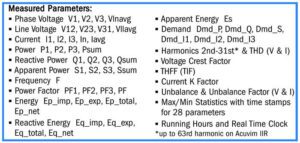 The Acuvim II can also perform power quality analysis, datalogging, revenue grade metering and web communication (with optional ethernet interface).
The Acuvim II can also perform power quality analysis, datalogging, revenue grade metering and web communication (with optional ethernet interface).
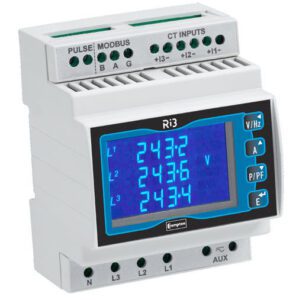 Some energy meters are designed to mount on a DIN rail. The Crompton Ri3 is a multi-function energy meter with three parameter LCD display. It measures the full set of power parameters, plus import and export kWh and kVAh. Pulse output and Modbus RTU are standard.
Some energy meters are designed to mount on a DIN rail. The Crompton Ri3 is a multi-function energy meter with three parameter LCD display. It measures the full set of power parameters, plus import and export kWh and kVAh. Pulse output and Modbus RTU are standard.
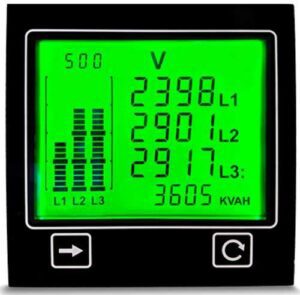 The Trumeter APM-PWR is a low-cost power meter with a four-parameter graphical readout. It measures the basic power triangle parameters for single or three phase systems, plus kWh or KVAh. One analog and two digital outputs are included, as well as Modbus RTU communications.
The Trumeter APM-PWR is a low-cost power meter with a four-parameter graphical readout. It measures the basic power triangle parameters for single or three phase systems, plus kWh or KVAh. One analog and two digital outputs are included, as well as Modbus RTU communications.
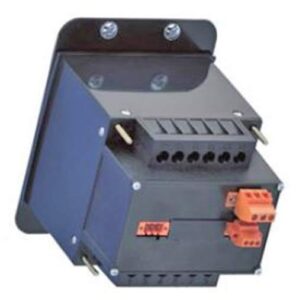 One example of a power and energy transducer is the Crompton 1560/1580. This product family is available in configurations for DIN or base mounting. These transducers measure 50 electrical parameters, including real, reactive and apparent power, plus real and apparent energy. Outputs include analog, pulse and Modbus RS-485.
One example of a power and energy transducer is the Crompton 1560/1580. This product family is available in configurations for DIN or base mounting. These transducers measure 50 electrical parameters, including real, reactive and apparent power, plus real and apparent energy. Outputs include analog, pulse and Modbus RS-485.
Power analyzers and energy dataloggers are two types of portable instruments that can make energy measurements. Unlike the panel meters and transducers described above, these products are usually supplied with voltage probes and current sensors.
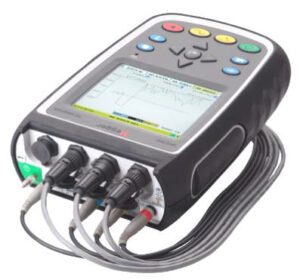 Power quality analyzers combine waveform display with extensive computation and recording capabilities. One example is the Megger MPQ1000 handheld 3-phase analyzer. Comprehensive power and energy measurements, waveforms, demand data, phase angles, harmonics, unbalance, flicker and more can be viewed in real time on the high-resolution graphic display. In both the scope and DVM modes, the MPQ1000 can record power, energy, RMS, sags, swells, transients down to 1 microsecond, harmonics, inter-harmonics, harmonic direction, THD, TDD, flicker, and other power quality parameters. Measurement data can be exported via USB, ethernet, memory stick or SD card. The PC-based software supports local and remote communications and includes advanced charting, waveform and analysis capabilities.
Power quality analyzers combine waveform display with extensive computation and recording capabilities. One example is the Megger MPQ1000 handheld 3-phase analyzer. Comprehensive power and energy measurements, waveforms, demand data, phase angles, harmonics, unbalance, flicker and more can be viewed in real time on the high-resolution graphic display. In both the scope and DVM modes, the MPQ1000 can record power, energy, RMS, sags, swells, transients down to 1 microsecond, harmonics, inter-harmonics, harmonic direction, THD, TDD, flicker, and other power quality parameters. Measurement data can be exported via USB, ethernet, memory stick or SD card. The PC-based software supports local and remote communications and includes advanced charting, waveform and analysis capabilities.
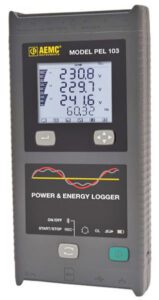 The AEMC is a power and energy logger for one, two (split phase) and three-phase (Y, ∆) systems. It measures and records three voltage and current inputs, watts, vars, VA and energy (kWh and kVA). Power factor, displacement power factor, crest factor, frequency and THD are also calculated and recorded. Data is stored on a removable SD card and can be viewed on the internal display or accessed remotely via ethernet or Bluetooth. Software included with the PEL103 provides the ability to view data from multiple units on a local network or over the internet for evaluation of energy usage anywhere in the world.
The AEMC is a power and energy logger for one, two (split phase) and three-phase (Y, ∆) systems. It measures and records three voltage and current inputs, watts, vars, VA and energy (kWh and kVA). Power factor, displacement power factor, crest factor, frequency and THD are also calculated and recorded. Data is stored on a removable SD card and can be viewed on the internal display or accessed remotely via ethernet or Bluetooth. Software included with the PEL103 provides the ability to view data from multiple units on a local network or over the internet for evaluation of energy usage anywhere in the world.
These are just a few of the instrumentation products available for measuring power consumption and energy usage. The Weschler application team can assist with the selection of suitable products for your measurement needs.
